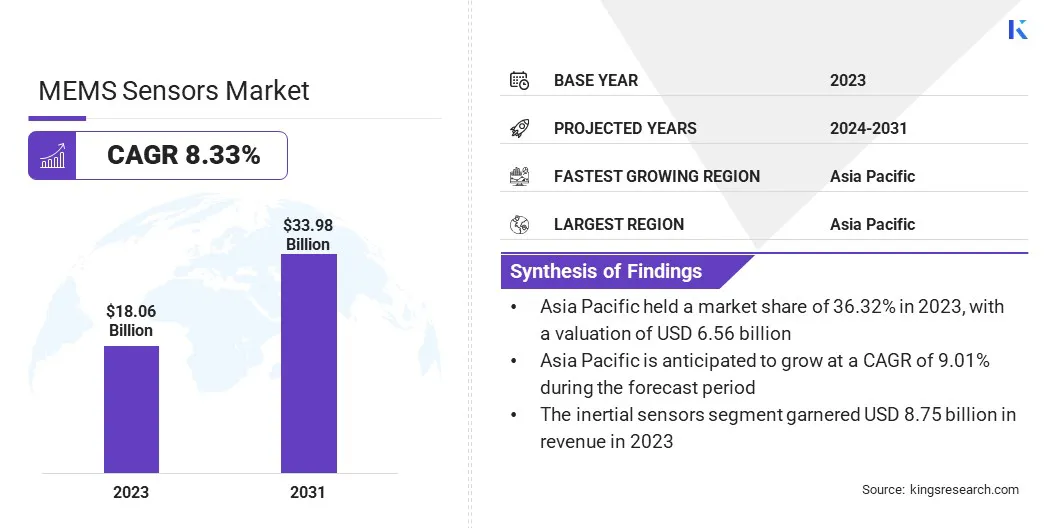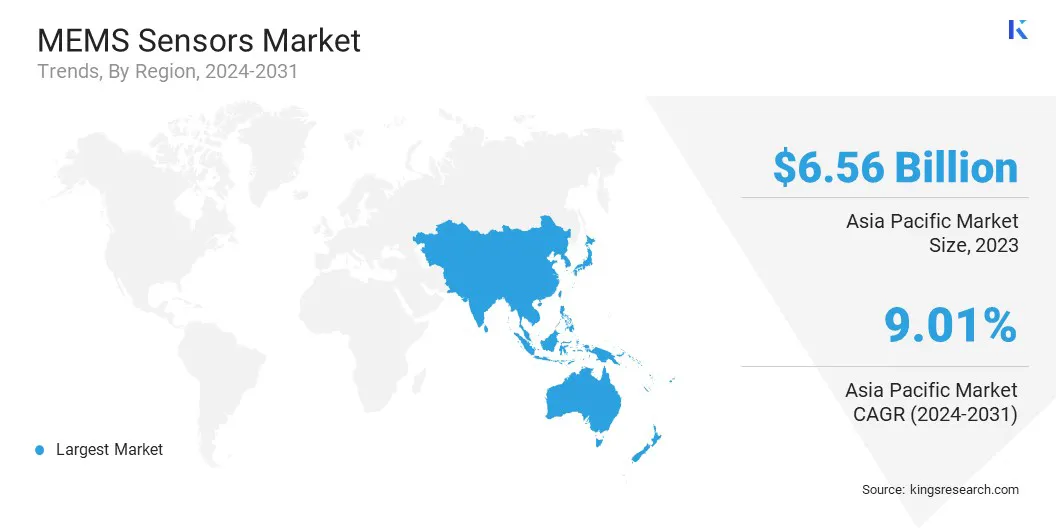Market Definition
The market refers to the industry involved in the production of MEMS sensors which can sense and measure different physical variables such as motion, temperature, pressure, and sound.
These sensors convert physical inputs into electrical signals, enabling precise monitoring and control across various applications. These sensors convert physical inputs into electrical signals, enabling precise monitoring and control across various applications.
MEMS Sensors Market Overview
Global MEMS sensors Market size was valued at USD 18.06 billion in 2023, which is estimated to grow from USD 19.41 billion in 2024 to USD 33.98 billion by 2031, at a CAGR of 8.33% from 2024 to 2031.
The miniaturization of technology is a key factor driving the market. As sensors become smaller and more powerful, they enable integration into a wide range of applications. This is leading to a broader adoption of MEMS sensors in various sectors such as consumer electronics, manufacturing, automotive, and healthcare.
Major companies operating in the MEMS sensors ndustry are Robert Bosch GmbH, STMicroelectronics, Infineon Technologies AG, Murata Manufacturing Co., Ltd, TDK Corporation, Analog Devices, Inc., ALPS ALPINE CO., LTD., Flusso ltd, Honeywell International Inc, NXP Semiconductors, AAC Technologies, Melexis, Qorvo, Inc., Syntiant Corp., and Panasonic Corporation.
The market is seeing significant expansion, particularly in wearable devices like fitness trackers, smartwatches, and health monitoring systems. These devices rely on MEMS sensors to monitor vital signs, movement, and environmental conditions with high precision and energy efficiency. As consumers increasingly prioritize health and fitness, the demand for compact, cost-effective, and reliable MEMS sensors is rising.
- In June 2024, TDK launched the InvenSense Sensor Partner Program to accelerate IoT innovation using MEMS sensors. This program supports the development of applications in wearables, healthcare devices, and robotics providing engineers with access to sensor technology, reference designs, and development kits.

Key Highlights
- The MEMS sensors industry size was recorded at USD 18.06 billion in 2023.
- The market is projected to grow at a CAGR of 8.33% from 2024 to 2031.
- Asia Pacific held a market share of 36.32% in 2023, with a valuation of USD 6.56 billion.
- The inertial sensors segment garnered USD 8.75 billion in revenue in 2023.
- The consumer electronics segment is expected to reach USD 13.26 billion by 2031.
- North America is anticipated to grow at a CAGR of 8.31% during the forecast period.
Market Driver
"Miniaturization of Technology"
The miniaturization of MEMS sensors is a significant growth driver for the market. As sensor technology continues to evolve, smaller and more efficient sensors are being incorporated into a wider array of products. This advancement allows MEMS sensors to be embedded in compact devices like wearables, medical equipment, and automotive systems.
These miniaturized sensors enable new functionalities, by providing more precise data and enhanced performance without increasing the size. This factors are driving its demand across various industries such as healthcare, automotive, and consumer electronics.
- In September 2024, TDK launched the Tronics AXO314, a closed-loop digital MEMS accelerometer designed for high-dynamics industrial applications. This compact, miniature and precise sensor offers enhanced vibration rejection, stability, and reliability, making it ideal for applications in harsh environments, including inertial navigation and positioning systems.
Market Challenge
"Sensor Calibration and Accuracy"
One of the key challenges in the MEMS sensors market is maintaining high accuracy and consistent calibration over time, especially in precision-demanding applications such as medical devices. Environmental factors such as temperature variations and mechanical stress can impact sensor performance, leading to reduced accuracy.
To address this, companies are developing advanced calibration techniques, such as real-time monitoring and software-based compensation methods. Additionally, manufacturers are integrating more robust materials and designs to ensure long-term reliability and minimize sensor drift.
Market Trend
"Wireless MEMS Sensors"
The trend toward wireless MEMS sensors is significantly transforming the MEMS sensor market. As industries demand more flexible and scalable solutions, wireless and battery-powered sensors enable remote, real-time monitoring without the constraints of wired connections.
By providing easier integration and deployment, these sensors enhance operational efficiency, facilitate predictive maintenance, and contribute to the advancement of IoT-based systems, boosting market growth and technological innovation.
- In January 2023, TDK announced a collaboration with Texas Instruments to launch the i3 Micro Module, the first sensor module with built-in edge AI and wireless mesh connectivity. This ultra-compact, battery-powered wireless MEMS sensor enables real-time anomaly prediction and condition-based monitoring for machinery, contributing to advancements in smart factory initiatives.
MEMS Sensors Market Report Snapshot
|
Segmentation
|
Details
|
|
By Sensor Type
|
Inertial Sensors, Pressure Sensors, Others
|
|
By End-User Industry
|
Consumer Electronics, Automotive, Healthcare, Others
|
|
By Region
|
North America: U.S., Canada, Mexico
|
|
Europe: France, UK, Spain, Germany, Italy, Russia, Rest of Europe
|
|
Asia-Pacific: China, Japan, India, Australia, ASEAN, South Korea, Rest of Asia-Pacific
|
|
Middle East & Africa: Turkey, UAE, Saudi Arabia, South Africa, Rest of Middle East & Africa
|
|
South America: Brazil, Argentina, Rest of South America
|
Market Segmentation
- By Sensor Type (Inertial Sensors, Pressure Sensors, Others): The inertial sensors segment earned USD 8.75 billion in 2023 due to increased demand for motion tracking and navigation systems across various industries.
- By End-User Industry (Consumer Electronics, Automotive, Healthcare, Others): The consumer electronics held 39.56% of the market in 2023, due to the growing integration of MEMS sensors in smartphones, wearables, and smart devices.
MEMS Sensors Market Regional Analysis
Based on region, the market has been classified into North America, Europe, Asia Pacific, Middle East & Africa, and Latin America.

Asia Pacific MEMS sensors market share stood around 36.32% in 2023 in the global market, with a valuation of USD 6.56 billion. The Asia-Pacific region remains the dominant market for MEMS sensors, driven by rapid technological advancements and growing demand across various industries such as automotive, consumer electronics, and healthcare.
The region's rapidly growing manufacturing capabilities, coupled with the increasing adoption of IoT and smart devices, contribute to its leadership in the market. Additionally, the growing focus on industrial automation and favorable government initiatives further strengthens Asia-Pacific's position in the global market.
- In December 2024, SonicEdge unveiled SonicTwin, the world's smallest integrated speaker-microphone solution designed for True Wireless Stereo (TWS) earbuds and headphones. SonicTwin utilizes MEMS technology to integrate both speaker and microphone functions into a compact, high-performance solution.
North America MEMS sensors industry is poised for significant growth at a robust CAGR of 8.31% over the forecast period. North America is emerging as the fast-growing region for the market, driven by strong demand across industries such as automotive, healthcare, and consumer electronics.
The rapid adoption of advanced technologies like autonomous vehicles, IoT, and wearable devices is increasing the utilization of MEMS sensors in this region. Additionally, the presence of key market players that are actively investing in research and development, and launching advanced MEMS sensors is further contributing to the growth of the market in North America.
Regulatory Frameworks
- The Bureau of Indian Standards (BIS) governs product quality and safety standards in India. MEMS sensors used in critical applications like automotive, medical, or industrial sectors must comply with the BIS standards.
- In the U.S., MEMS sensors used in medical devices must comply with the U.S. Food and Drug Administration (FDA) regulations, ensuring safety and effectiveness.
- In the European Union, MEMS sensors must comply with the European Union’s CE marking requirements to ensure product safety and performance. MEMS sensors must adhere to directives such as the Low Voltage Directive (LVD), Electromagnetic Compatibility Directive (EMC), and Radio Equipment Directive (RED), depending on their application.
Competitive Landscape
Companies in the MEMS sensors industry are focusing on enhancing sensor capabilities, such as improving accuracy, power efficiency, and miniaturization. They are integrating advanced technologies like wireless connectivity and edge AI to enable real-time monitoring and predictive maintenance.
These innovations aim to support diverse industries, ranging from healthcare to renewable energy while advancing smart and sustainable solutions.
- In March 2023, Envision Energy partnered with Analog Devices to integrate MEMS sensor technology into smart wind turbines, enhancing safety and predictive maintenance. This collaboration enables real-time monitoring of wind turbine components, advancing green energy solutions and operational reliability.
List of Key Companies in MEMS Sensors Market:
- Robert Bosch GmbH
- STMicroelectronics
- Infineon Technologies AG
- Murata Manufacturing Co., Ltd
- TDK Corporation
- Analog Devices, Inc.
- ALPS ALPINE CO., LTD.
- Flusso ltd
- Honeywell International Inc
- NXP Semiconductors
- AAC Technologies
- Melexis
- Qorvo, Inc
- Syntiant Corp.
- Panasonic Corporation
Recent Developments (Funding/Product Launch)
- In January 2025, TDK presented the WeWALK Smart Cane 2 at CES, showcasing its innovative accessibility features powered by InvenSense MEMS sensors. This smart cane integrates Inertial Measurement Unit (IMU) motion sensors, MEMS microphones, and ultrasonic sensors for enhanced navigation, voice prompts, and obstacle avoidance for visually impaired users.
- In January 2025, Omnitron Sensors secured USD 13 million in series A funding to accelerate the mass production of MEMS step-scanning mirrors. This funding will support the expansion of Omnitron’s engineering and operations teams, enabling the company to meet the growing demand for MEMS sensors in various applications. This includes including optical cross-connects for AI data centers, LiDAR subsystems for autonomous vehicles, and see-through displays for extended reality devices.
- In May 2024, STMicroelectronics launched MEMS Studio, an all-in-one desktop software solution designed to accelerate MEMS sensor development. It integrates with STM32 microcontrollers, supporting motion, environmental, and infrared sensors for simplified data analysis and algorithm development for next-gen applications.


